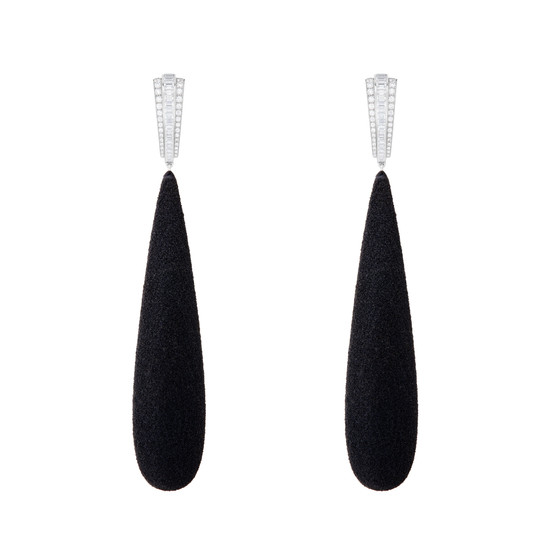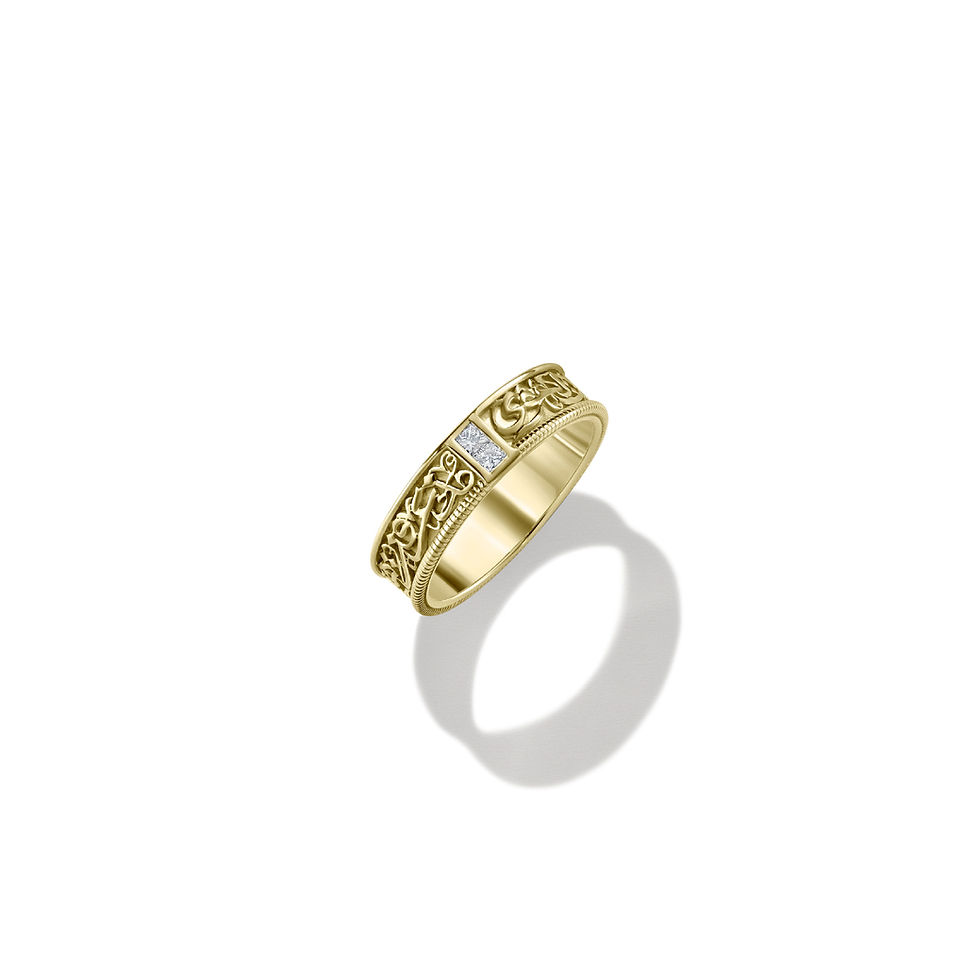Boucheron High Jewelry collection, “Or Bleu”
- DUNES

- Jun 30, 2024
- 8 min read
Claire Choisne dedicates her new Carte Blanche to water, a vital and precious resource. More than simply High Jewelry collection, “Or Bleu” is an ode to the memory of water.
She was inspired by the waters of Iceland – strong, powerful, raw. In the rush of a waterfall, she saw a diamond necklace. In the surge of waves, shoulder jewelry. In the heart of a glacier, a rock crystal bracelet seemingly sculpted by the passage of water.
Once again, the Maison pushes creative boundaries, with these naturalistic impressions of the color, texture, flow, reflections and transparency of water. These High Jewelry pieces are like snapshots of nature, frozen in its rawest state. In this collection, Boucheron captures the beauty of water in 26 High Jewelry creations.
A vital water, whose beauty is encapsulated for eternity.
1. cascade – waterfall
When Claire Choisne looked at this waterfall, she saw a necklace coursing down the body.
Measuring 148 centimeters, this white gold and diamond piece is the longest ever made in Boucheron’s ateliers. “Cascade” is a wellspring of surprises, metamorphosing into a shorter necklace once two detachable sections are transformed into earrings. Boucheron’s workshops stayed true to the source of inspiration by crafting a piece as fine as a filament. Given its oversize dimensions, this called for the utmost precision and patience. With 1816 diamonds of different sizes along its length, “Cascade” is painstakingly set in a single articulated row to give it a beautiful suppleness and strikingly realistic fall.
Necklace paved with diamonds, in white gold. Necklace made in the tradition of Boucheron multi-wear pieces, convertible into a pair of earrings. 3000 hours of craftmanship.
II. ondes – waves
A falling drop breaks the fragile balance of the water's surface. It was this exact instant that inspired the “Ondes” set.
To capture this organic ripple motion, the Boucheron Studio simulated this on a 3D software, which then dictated the volumes of a necklace and two rings. What material would most realistically reproduce the ripples – transparent ceramic? Sapphire glass? Claire Choisne decided on rock crystal, sculpted and polished. The pieces are remarkable both for their thinness and their delicate rippling circles. The metal is reduced to a minimum in this necklace designed as a second skin. The jewelers faced a real challenge, having not only to sculpt the crystal, but also to ensure the necklace follows the body’s contours. And because transparency is uncompromising, 4542 round diamonds in this piece are invisibly set underneath the rock crystal. At the epicenter of each concentric ripple sits a diamond, flush with the surface, enclosed in a bezel setting.
Necklace set with rock crystal and paved with diamonds, in white gold. 5050 hours of craftmanship.
Ring set with a 1.02 ct E VVS2 round diamond and rock crystal, paved with diamonds, in white gold. 305 hours of craftmanship.
Ring set with rock crystal and paved with diamonds, in white gold. 305 hours of craftmanship.
III. eau d’encre – ink-black water
Far from being crystal-clear, Iceland's inky-black waters expose the harsh side of nature. Claire Choisne channeled their intense color in these two pieces, the “Eau d'Encre” cuff bracelet and ring.
Boucheron selected obsidian, a volcanic stone of a beautiful, deep jet-black. The bracelet is made from two identical blocks of this glassy rock, sculpted in a pattern of 3D-simulated waves to recreate the rough motion of water. As for the ring set with a 2.01-carat D-VVS1 pear-shaped diamond it was the obsidian that dictated its design. A snow setting was applied to both pieces to contrast with the deep black rock. It also gently resembles the white foam of surf rolling over beaches of black sand.
Bracelet set with obsidian and paved with diamonds, in titanium and white gold. 355 hours of craftmanship.
Ring set with a 2.01 ct D VVS1 pear diamond and obsidian, paved with diamonds, in white gold. 240 hours of craftmanship.
IV. eau forte – etching
This bracelet draws its inspiration from the instant when a wave swells one final time before breaking over the black sand. “Eau Forte” is also the name of the process used in crafting the relief on this bracelet.
Boucheron’s craftsmen employ a technique known as eau-forte in French. This traditional method uses a chemical solution to etch designs into metal with tremendous precision. First, a coat of acid-resistant wax is applied to the white gold plate of the bracelet, and then the wave design created in the Studio is etched into the wax. Then, the piece is submerged in an acid solution which dissolves the gold in places where it hasn’t been covered in wax. The longer it is immersed in the solution, the deeper the hollows will be. This is how the contours of this white gold wave are sculpted.
On one side, the white foam of waves; on the other, black sand. To paint this landscape, Boucheron’s artisans first applied successive layers of white lacquer by airbrush. They then used digital laser printing to set black lacquer into the hollows left by the etching. The final contours of the wave emerge from this combination of etching and 3D printing, two processes that call for precision to within the nearest millimeter.
Once the wave has completed its trajectory, diamond paving illuminates the other half of the bracelet. The final touch is transparent varnish, five coats to seal the ephemeral for all eternity, locking in the dazzling sparkle of this High Jewelry piece.
Bracelet paved with diamonds and decorated with black ink, in white gold. 900 hours of craftsmanship.
V. sable noir – black sand
Foaming surf crashing on a black sandy shore: this stark opposition between light and dark inspired Claire Choisne to design a series of pieces that reproduce those colors, contrasts and, above all, material textures. With "Sable Noir", Boucheron crystallized this black sand in three pieces.
This is not the first time the Maison has used sand in a High Jewelry collection. In 2015, sand from the Thar Desert was encapsulated in a necklace. But this year, black sand was used and compacted using a 3D printing technique. Polymer binder was precision-sprayed onto the sand in very fine layers, making the grains adhere to one another until the desired shape was achieved. Traditionally used in the automotive and aeronautics industries, this technique yields a very hardwearing material with the iridescent texture of the sand showing through. The necklace clasp is discreetly positioned behind the two diamond-set sections. Using the same 3D printing technique, the pendant earrings are formed into droplets.
The centerpiece of this triptych is a cuff bracelet which shows no metal edges, as if it were simply sculpted from black sand. A naturalistic snow setting makes the diamonds in this piece sparkle with extraordinary brilliance.
Bracelet in black sand and paved with diamonds, in white gold. 900 hours of craftmanship.
Necklace in black sand and paved with diamonds, in white gold. 620 hours of craftmanship.
Pendant earrings in black sand and paved with diamonds, in white gold. 130 hours of craftmanship.
VI. écume – foam
For a fleeting moment, the foam breaks the monochromatic tableau of Iceland's beaches. This instant inspired the creation of two rings that both echo and oppose each other through the chromatic contrasts of their materials.
The first ring foregrounds obsidian again. Cut from a single block of deep, glassy black, the rock contrasts starkly with the brilliance of diamonds set in white gold. Supporting the composition is a ring made of titanium, a metal four times lighter than gold. This intricate union posed a challenge for Boucheron’s jewelers, who had to master the complexities of cutting volcanic obsidian.
Foaming surf crashes on the cliffs, leaving its imprint. The second ring uses rock crystal – a material much prized by the Maison – in an identical design, but this time playing with transparency. “Écume” invites contemplation of the jagged, towering cliffs along Iceland’s coast, represented here by an extremely precise cut. The white gold and diamond foam interlocks so flawlessly with its rock crystal counter-form that the technical virtuosity, though in evidence, is all but forgotten.
Ring set with obsidian and paved with diamonds, in titanium. 50 hours of craftmanship.
Ring set with rock crystal and paved with diamonds, in titanium. 50 hours of craftmanship.
VII. iceberg
On a black sand beach lay blocks of ice, glittering like diamonds under the sun’s reflected rays. Iceland’s ‘Diamond Beach’ is the place that inspired a necklace and a pair of earrings that reproduce the plays of light and transparency of these ephemeral sculptures.
Sandblasting the rock crystal gives it the same frosted effect as icebergs stranded on the beach. Boucheron’s craftsmen loaded these pieces with trompe-l'œil illusions. Instead of securing the diamonds with the usual white gold prongs, they sculpted the crystal to hold the gemstones directly embedded within it. Similarly, the multitude of articulations that link the elements together are indiscernible to the naked eye, because this piece seems to levitate around the neck. Some of the droplets hold a precious secret: sparkling pavé diamonds are set under the rock crystal, their brilliance enhanced by its magnifying effect.
Necklace set with rock crystal and paved with diamonds, in white gold. 2000 hours of craftsmanship.
Pendant earrings set with rock crystal and paved with diamonds, in white gold. 410 hours of craftmanship.
VIII. vague – wave
The sea unleashes its fury. Serving as both a brooch and a hair jewel, ‘Vague’ pays tribute to the power of water. It also echoes a 1910 tiara from the archives, itself inspired by Hokusai's The Great Wave off Kanagawa.
This piece draws on traditional High Jewelry savoir-faire to convey the original design’s organic sense of poetry. Each detail was sculpted by hand using a technique known as lost-wax casting, where the desired form is first fashioned in wax. Then a mold is set around it, to create a negative mold of the original form. The wax is then melted away and gold is poured into the wave-shaped mold. Finally, 851 round diamonds are set into the gold, weighing a total of 20 carats.
Asymmetrical earrings paved with diamonds, in white gold. Earrings made in the tradition of Boucheron multi-wear pieces, convertible into a brooch. 650 hours of craftsmanship.
IX. flots – swell
A chute of water rushing down the rocky slopes. This landscape gave rise to a jewel. The “Flots” brooch also pays tribute to another piece in the Boucheron archives, a comb dating from 1901.
As if suspended on threads, the diamonds mimic ribbons of cascading water, because they are set on separate free-hanging strips that ripple with the wearer’s every movement. To realistically reproduce a chute of falling water, the gem-setters mounted the diamonds in a “copeaux” setting that leaves the metal around the stones virtually imperceptible. This setting is rarely used in today’s world but can sometimes be found on antique jewelry, such as the 1901 archive piece. As a final touch, alternating round diamonds of different sizes gives the piece an even more lifelike feel.
Necktie paved with diamonds, in white gold. 500 hours of craftsmanship.
X. ciel de glace – icy sky
Sculpted by the elemental forces of wind and time, Iceland's ice caves inspired the “Ciel de Glace” cuff bracelet. This piece pays tribute to the beauty of these natural settings – their colors, their textures, their windswept patterns.
The white gold base of this cuff is pavé-set with diamonds and a gradient of sapphires spanning five shades of blue. This icy sky was made from a single flawless block of rock crystal – totally devoid of any inclusions – and carved with the undulating textures of Iceland’s renowned ice caves. An invisible clasp preserves the immaculate beauty of this piece.
Bracelet set with rock crystal, paved with diamonds and blue sapphires, in white gold. 535 hours of craftsmanship.
XI. givre – frost
To capture the quality of water in this intermediate state, Claire Choisne created “Givre,” a new kind of jewelry set that recreates a cascade of stalactites dripping down the body. A hair jewel, an earring, a shoulder jewel and a ring succeed one another in a melting flow dictated by gravity.
Here again, metal takes a back seat to highlight the precious elements of pearl, mother-of-pearl and diamonds. No fewer than 691 pearls were needed to craft these pieces. Fulfilling the Creative Studio’s vision posed a real challenge for Boucheron’s stone experts: they had to assemble a group of pearls that are all exactly the same color but vary in dimension. The ring itself appears to be in a constant flow state, with a rotating ball-bearing mechanism that keeps its elements always hanging vertically downwards, like ice melting.








































Comments